View: Global liquidity is the key factor driving Bitcoin price

Reprinted from panewslab
04/20/2025·1MWritten by: fejau
Compiled by: Luffy, Foresight News
I want to write down some things I have been thinking about repeatedly, that is, how Bitcoin may perform when it undergoes a major change in capital flow patterns that has never been seen since its birth. I think that once the deleveraging process is over, Bitcoin will usher in an excellent trading opportunity. In this post, I will elaborate on my thoughts in detail.
What are the key drivers of Bitcoin price?
I will draw on Michael Howell’s research on historical drivers of Bitcoin price trends and then use these to further understand how intertwined factors may evolve in the near future.
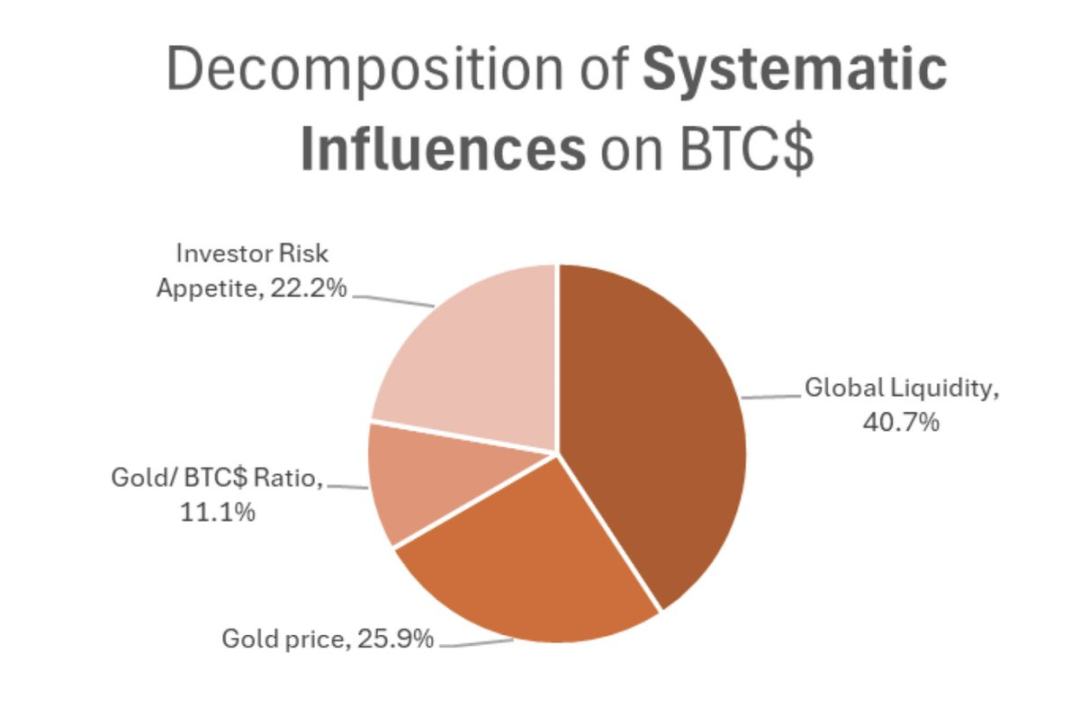
As shown in the above image, the price of Bitcoin is driven by these factors:
- Investors' overall preference for high-risk, high-beta assets
- The correlation between Bitcoin and gold
- Global liquidity
Since 2021, I understand that the simple framework of risk appetite, gold performance and global liquidity is to take the fiscal deficit as a proportion of GDP as a quick observation to see the fiscal stimulus that has dominated the global market since 2021.
Mechanistically speaking, the higher the proportion of fiscal deficit in GDP, it will lead to intensified inflation and rising nominal GDP. Therefore, for enterprises, since revenue is a nominal indicator, their revenue will also increase accordingly. This is a good thing for companies that can enjoy economies of scale.
To a large extent, monetary policy has always been at a secondary position in the face of fiscal stimulus, and fiscal stimulus is the main driving force for risk asset activities. As George Robertson often updates this chart, monetary stimulus in the United States has been very weak compared to fiscal stimulus, so I will not consider monetary stimulus for the time being in this discussion.
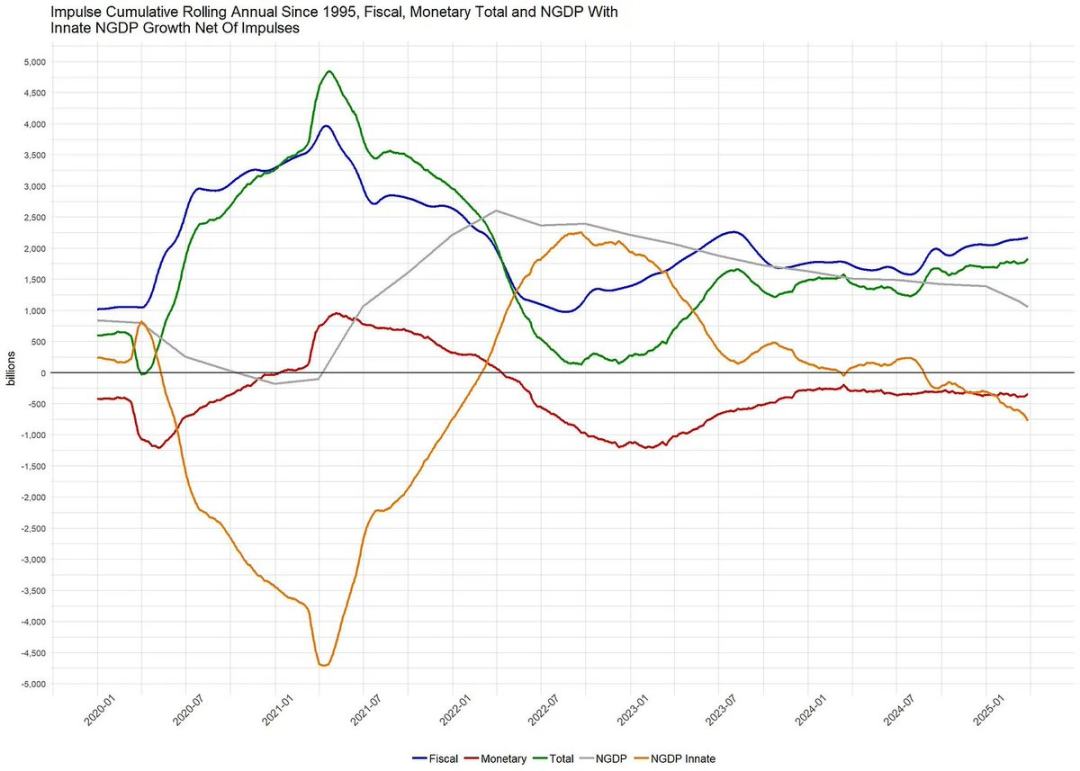
From the following chart of major Western developed economies, we can see that the U.S. fiscal deficit accounts for much higher proportion of GDP than other countries.

With such a huge fiscal deficit in the United States, revenue growth dominates, which makes the U.S. stock market perform better than other economies:
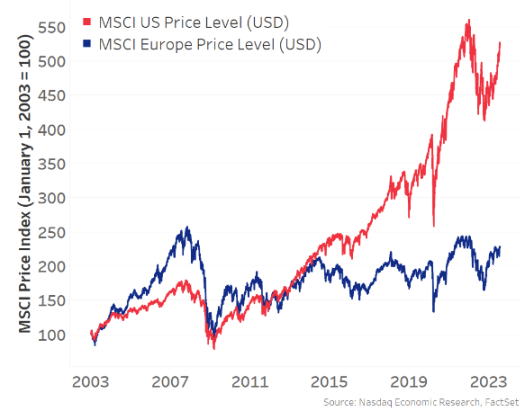
The U.S. stock market has always been the main marginal driver of risk asset growth, wealth effects, and global liquidity, and has therefore become a gathering place for global capital, because in the United States, capital can be treated best. Due to the dynamics of capital inflows into the United States, coupled with a huge trade deficit, the United States trades goods for foreign exchange held by foreign countries, which in turn reinvest the U.S. dollar in assets denominated in US dollars (such as U.S. Treasury bonds and "Big Seven" technology stocks), the U.S. has become the main driver of all global risk appetite:
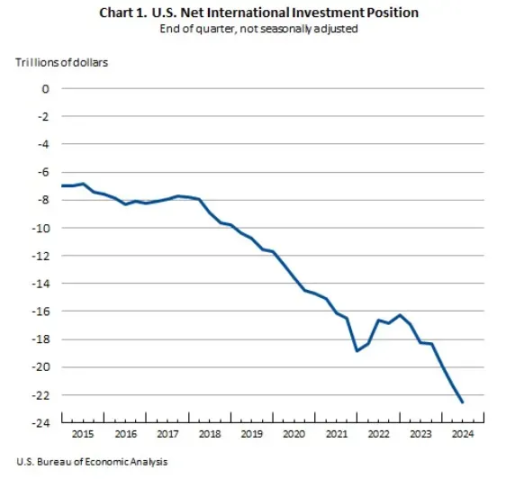
Now, back to the aforementioned Michael Howell's research. Over the past decade, risk appetite and global liquidity have been driven primarily by the United States, and this trend has accelerated since the COVID-19 pandemic as the U.S. fiscal deficit is extremely large compared to other countries.
Because of this, although Bitcoin is a global liquid asset (not just related to the United States), it has shown a positive correlation with U.S. stock markets and this correlation has grown since 2021:
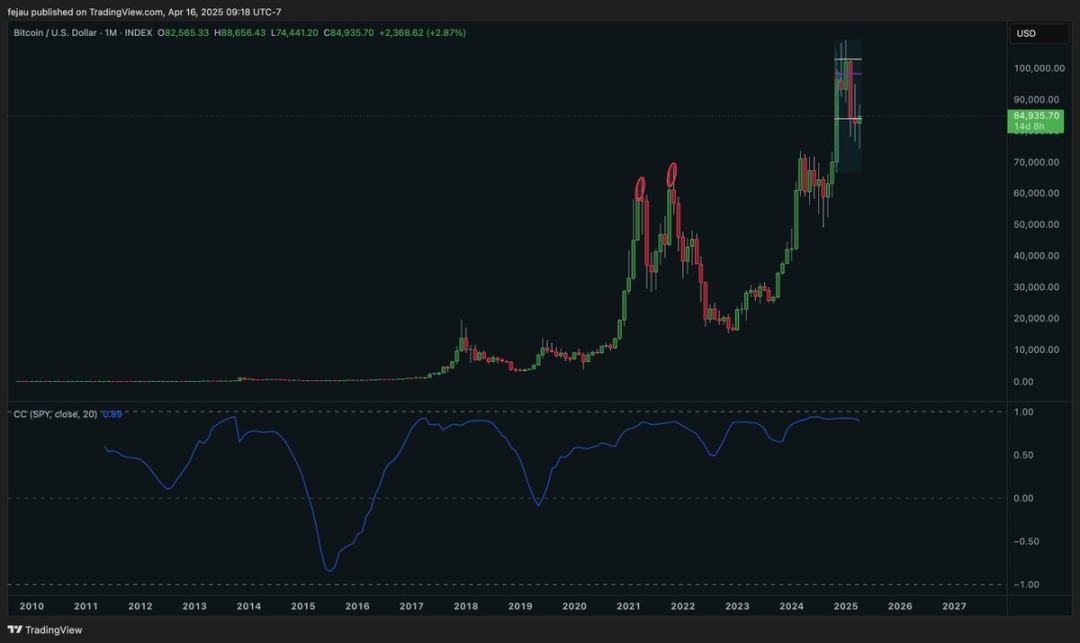
Now, I think this correlation between Bitcoin and the U.S. stock market is false. When I use the word "false correlation", I speak it statistically, that is, I think the third causal variable that is not shown in the correlation analysis is the real driver. I think this factor is global liquidity, as we said earlier, global liquidity has been dominated by the United States for the past decade.
When we dig into statistical significance, we must also determine causality, not just positive correlations. Fortunately, Michael Howell has done some great work in this regard, and he identified the causality relationship between global liquidity and Bitcoin through the Granger Causality test:
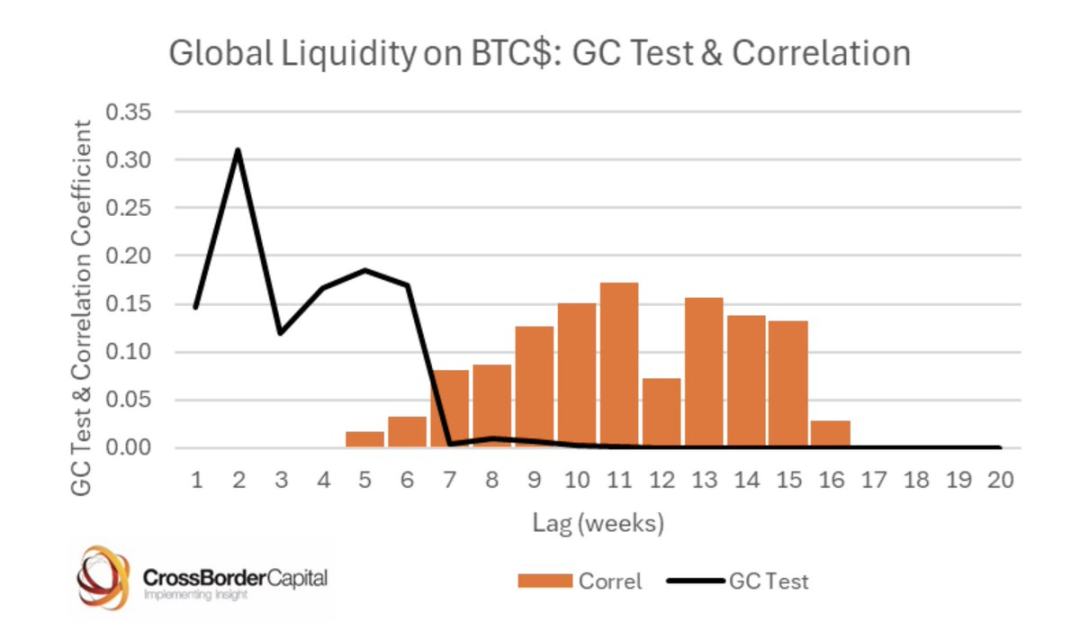
What conclusions can this allow us to draw as a benchmark for our further analysis?
Bitcoin prices are driven primarily by global liquidity, and because the United States has always been the dominant factor in global liquidity growth, there has been a false correlation between Bitcoin and U.S. stock markets.
Over the past month, some major views have emerged as we all speculate on Trump’s trade policy goals and the restructuring of global capital and commodity flows. I'll summarize them as follows:
- The Trump administration hopes to reduce its trade deficit with other countries, which, by mechanism, means that the flow of dollars to foreign countries will be reduced, which would have been reinvested in U.S. assets. If this is to be avoided, the trade deficit cannot be narrowed.
- The Trump administration believes that foreign currencies are artificially suppressed and the dollar is artificially overvalued, and hopes to rebalance the situation. In short, a weaker dollar and stronger currencies in other countries will lead to higher interest rates in other countries, thereby prompting capital to return to their home country to obtain these interest rate returns, because from a foreign exchange-adjusted perspective, these returns will be better and will also promote the development of their own stock markets.
- Trump's "first shots, then ask questions" in trade negotiations is pushing other countries around the world to get rid of a meager fiscal deficit compared to the United States and invest in defense, infrastructure, and overall protectionist government investments to make themselves more self-sustaining. Regardless of whether the tariff negotiations are easing (such as negotiations with China), I think "the elves have been released from the bottle", countries will continue this effort and will not look back easily.
- Trump hopes other countries increase their defense spending as a percentage of GDP, as the United States bears a lot of costs in this regard. This will also increase the fiscal deficit.
I will put my personal views on these views aside, because many people have commented on this, and I will briefly focus on the impact that these views may have if they develop according to their logic:
- Funds will leave assets denominated in USD and return to their home country. This means that the performance of the U.S. stock market will be worse than the rest of the world, bond yields will rise, and the dollar will depreciate.
- The countries where these funds flow back will no longer be restricted in their fiscal deficits, and other economies will begin to spend heavily and print money to fill the growing fiscal deficits.
- As the United States continues to transition from a global capital partner to a protectionist role, holders of dollar assets will have to raise the risk premium associated with these previously considered high-quality assets and must set a wider margin of safety for these assets. When this happens, this will lead to higher bond yields and foreign central banks will be interested in diversifying their balance sheets, no longer relying solely on U.S. Treasuries, but instead shifting to other neutral assets, such as gold. Similarly, foreign sovereign wealth funds and pension funds may also make such diversified adjustments to their portfolios.
- Contrary to these views, the United States is the center of innovation and technology-driven growth, and no country can replace this position. Europe's bureaucracy and socialism are too strong to develop capitalism like the United States. I understand this view, and it may mean that this will not be a trend that lasts for years, but more likely a medium-term trend.
Going back to the title of this article, the first round of trading is to sell over-equipped US dollar assets around the world and avoid the ongoing deleveraging process. As global allocation of these assets is severely overstandard, the deleveraging process can become a mess when large fund managers and more speculative and strict stop loss-setting participants like multi-strategy hedge funds hit risk limits. When this happens, there will be days similar to margin notifications, and a large number of assets need to be sold to raise cash. At present, the key is to survive in the process and retain sufficient cash reserves.
However, as the deleveraging process stabilizes, the next round of trading begins. Diversify the portfolio and include foreign stocks, foreign bonds, gold, commodities, and even Bitcoin.
In the days of market rotation and no margin notices, we have begun to see this dynamic gradually forming. The U.S. dollar index (DXY) fell, U.S. stocks performed worse than stocks in the rest of the world, gold prices soared, and Bitcoin was surprisingly strong compared to traditional U.S. technology stocks.
I think that as this happens, the marginal growth of global liquidity will shift to a completely opposite state we have been accustomed to in the past. The rest of the world will take over the banner of increasing global liquidity and risk appetite.
As I think about the risks of making such diversified investments in the context of a global trade war, I worry that deep investment in risky assets in other countries will bring tail risks, as there may be some negative headlines about tariffs that will affect these assets. Therefore, in this transformation, gold and Bitcoin have become the first choice for global diversified investments in my eyes.
Gold is currently performing extremely strongly, setting record highs every day. However, while Bitcoin has been surprisingly strong throughout the transition of the landscape, its correlation with risk appetite has so far limited its gains and failed to keep up with the outstanding performance of gold.
So, as we move towards global capital rebalancing, I think the next trading opportunity after this round of transactions lies in Bitcoin.
When I compared this framework with Howell's relevance study, I found that they fit each other:
- The U.S. stock market will not be affected by global liquidity, but by liquidity measured by fiscal stimulus, and some capital inflows. However, Bitcoin is a global asset that reflects the broader situation of global liquidity.
- As this view gradually becomes recognized and risk allocation continues to rebalance, I think risk appetite will be driven by the rest of the world, not the United States.
- Gold couldn't have performed better, and Bitcoin has some correlation with gold, which is also in line with our expectations.
Taking all the above factors into consideration, I have seen the possibility of Bitcoin decoupling from US technology stocks for the first time in my life. I know that this is a high-risk idea and often marks a local high in Bitcoin prices. But the difference is that this time the flow of funds may undergo significant and lasting changes.
So, for a macro trader like me who pursues risks, Bitcoin feels like the most worthy transaction after this round of trading. You can't impose tariffs on Bitcoin, it doesn't care about which country it is within the boundaries of, it provides high beta returns for the portfolio, and there is no tail risk associated with US tech stocks, I don't need to judge whether the EU can solve its own problems, and it provides exposure to global liquidity, not just US liquidity.
This market structure is an opportunity for Bitcoin. Once the dust of deleveraging is settled, it will start first and accelerate forward.



 chaincatcher
chaincatcher
 jinse
jinse